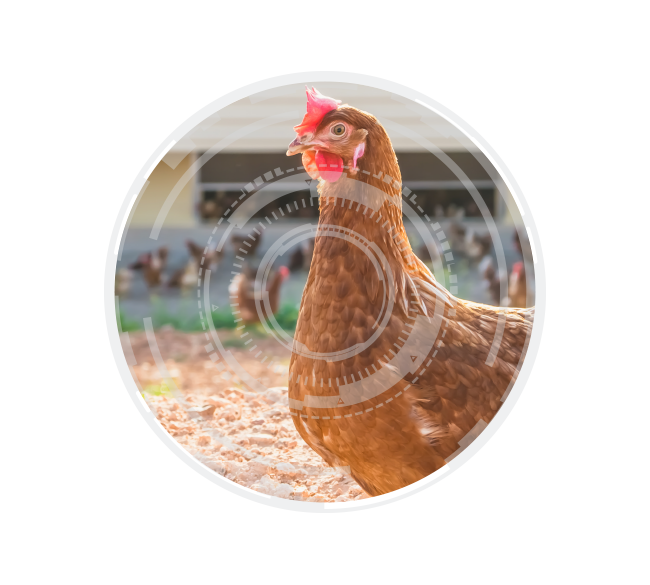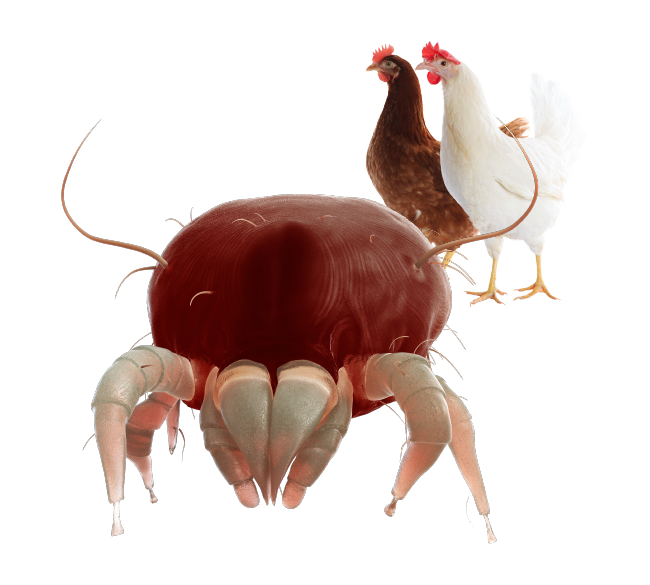
My interest in endocrinology helped locate the genetic locus explaining the largest differences in growth in poultry and the gene responsible for a genetic locus contributing to bone strength. We continue to use genetics and physiology to develop strategies utilising traditional or genomic selection to tackle problems as diverse as osteoporosis in laying hens, growth and reproduction in meat type birds or egg and shell quality in laying hens. These traits all have socio-economic importance to the poultry industry.
Abstract
The belief that selection for increased egg production is a cause of bone quality issues in laying hens has been widespread. However the evidence that there is a link between the rate of lay and bone quality does not support this. A number of pieces of evidence reinforce the need to find alternative explanations. Issues of bone quality, in particular the keel have existed long before modern hybrid breeding.
Comparisons of high versus lower producing lines do not show a consistent trend in bone quality. Within line comparisons do not support egg laying number as a factor in bone quality nor did selection experiments. Problems with bone quality appear to be more likely earlier in a hens laying life, suggesting the issue is not with the number of eggs laid.
Other explanations for problems with bone quality need to be examined including the design of the housing, the level of activity, the control of puberty, enabling selection for skeletal quality and of course continually ensuring optimal nutrition during rearing and laying.
INTRODUCTION
Why does egg production seem unlikely as a major cause of bone quality issues?
1-Keel bone damage has been identified for at least 150 years and Darwin in his pursuit of the hypothesis of disuse noted that around 88% of the poultry he examined had deformed keels (Darwin, 1868). Darwin believed that the keel, as the point of attachment of the flight muscle was relatively atrophied due to the loss of the need to fly in domestic chickens. Evidence of keel bone deformities was also reported in the 1930’s (Warren, 1937). Carstens et al. (1936) reported high incidences of keel bone deformations in male and female Leghorn and Italian breeds (figure 1). In similar lines differing in egg production, there was some evidence the higher laying lines had worse bone quality (Eusemann et al., 2018a, Habig et al., 2017) but the results for white hens was less clear (Habig et al. 2017). In another comparison between high egg producing breeds, the breed with the highest egg production actually had better bone quality (Kaeppeli et al., 2011).

2-Selection for better bone quality occurred with no reduction in egg production so the two factors seem unlikely to be genetically connected (Fleming et al., 2006). Looking in two lines of hen the number of eggs laid after peak production showed no relationship with bone quality despite large differences in individual egg production (Dunn et al., 2021).
3-If progressive loss of bone quality was related to egg production it would get worse as the hens age. In fact an assessment of fracture risk with a testing regime noted that the risk increased after the onset of lay but actually decreased as the hens aged (Toscano et al., 2018). This is despite high levels of egg production and this seems to be in line with observations in commercial flocks (Toscano et al., 2015) Petrik et al., 2015)
4-It is possible to confuse egg laying with egg number. The act of laying eggs requires large physiological changes to a hen’s biology, featuring the secretion of oestrogen by the ovaries. This results in behavioural effects and of course the growth of the oviduct as it does in all vertebrates. In birds and reptiles that lay hard shelled eggs it also results in the production of medullary bone as an adaption to the store calcium. If the supplies of calcium in the medullary bone are not sufficient bone quality can be effected. There are a number of examples were not laying eggs versus laying eggs is accompanied by better bone quality. Examples include pharmacological prevention of egg laying (Eusemann et al., 2018b) or comparing non-laying cockerels with hens (Fleming et al., 2004). This is not the same as saying greater egg production is a cause of bone quality issues.
STUDIES
If as it seems the number of eggs a hen lays is not a major factor in issues of bone quality what are the likely causes? These were rehearsed in the review in 2020 (Toscano et al., 2020). The potential factors identified were age at puberty, late ossification of the keel, bone disease and low mobility. The obvious factor missing is the environment which was assumed to be a cause of damage in the review. We should also never forget nutrition. If the supply of calcium during rearing or laying is not optimal problems of bone quality occur. This is rapidly obvious when we manipulate calcium and phosphorus ratios during lay (Figure 2).
There have been many studies that look at the hens environment, specifically alternative systems with a complex system of furniture versus cages that have very limited obstacles.
Despite the increased chance of movement allowing the development of stronger bones most studies find that the incidence of damage is greater in alternative systems (Sandilands et al., 2009).
Reduced mobility as in all animals reduces bone strength. Giving hens the opportunity to exercise always results in better bone strength e.g. (Casey-Trott et al., 2017, Fleming et al., 2006, Regmi et al., 2015). The important caveat is that must not result in increased opportunity for damage as outlined above.
The timing of sexual maturity is probably an important factor in ensuring good bone quality.
A relationship was observed at the genetic level between puberty and bone quality in one line but not another (Dunn et al., 2021). Events at puberty are complex and the issue of body weight and skeletal development are linked in a complex genetic interaction.
However puberty can also be manipulated by diet and light, unfortunately getting the evidence for these management factors on bone quality has been relatively difficult.
One study that did associate puberty with bone quality indicated hens without keel damage reached puberty later (Gebhardt-Henrich and Fröhlich, 2015). The fact that the keel bone is late to ossify may make it more susceptible, but this has not been tested.

Conclusions
In conclusion the issue of bone quality in laying hens is a complex one. If there are to be improvements there needs to be reliable methods to make genetic progress. But progress can be made as it has been possible to reduce the incidence of damage by retrospective selection (Fleming et al., 2006), but that is not practical for normal genetic selection. Targeting management and nutrition alongside genetics should mean it is possible to improve the skeleton to a level where damage is unlikely, although it will never be possible to eliminate risk from the environment completely. As Darwin was aware, it should also be borne in mind that the keel in a chicken is a structure that has likely been under natural selection to reduce in size and possibly mineralisation due to his hypothesis of disuse . This was happening long before modern genetics were applied to poultry.

References
CARSTENS, P., WENZLER, G.& PRUEFER, J. (1936) Archiv fuer Gefluegelk. 10: 97 – 128.CASEY-TROTT, T.M., KORVER, D.R., GUERIN, M.T., SANDILANDS, V., TORREY, S. & WIDOWSKI, T.M. (2017) Opportunities for exercise during pullet rearing, Part II: Long-term effects on bone characteristics of adult laying hens at the end-of-lay. Poultry Science, 96: 2518-2527.
DARWIN, C.R. (1868) The variation of animals and plants under domestication. , Vol. 1, (London, John Murray).
DUNN, I.C., DE KONING, D.J., MCCORMACK, H.A., FLEMING, R.H., WILSON, P.W., ANDERSSON, B., SCHMUTZ, M., BENAVIDES, C., DOMINGUEZ-GASCA, N., SANCHEZ-RODRIGUEZ, E. & RODRIGUEZ-
NAVARRO, A.B. (2021) No evidence that selection for egg production persistency causes loss of bone quality in laying hens. Genetics Selection Evolution, 53: 11.
EUSEMANN, B.K., BAULAIN, U., SCHRADER, L., THONE-REINEKE, C., PATT, A. & PETOW, S. (2018a) Radiographic examination of keel bone damage in living laying hens of different strains kept in two housing systems. PLoS ONE, 13.
EUSEMANN, B.K., SHARIFI, A.R., PATT, A., REINHARD, A.K., SCHRADER, L., THONE-REINEKE, C. & PETOW, S. (2018b) Influence of a Sustained Release Deslorelin Acetate Implant on Reproductive Physiology and Associated Traits in Laying Hens. Frontiers in Physiology, 9.
FLEMING, R.H., MCCORMACK, H.A., MCTEIR, L. & WHITEHEAD, C.C. (2004) Incidence, pathology and prevention of keel bone deformities in the laying hen. British Poultry Science, 45: 320-330.
FLEMING, R.H., MCCORMACK, H.A., MCTEIR, L. & WHITEHEAD, C.C. (2006) Relationships between genetic, environmental and nutritional factors influencing osteoporosis in laying hens. British Poultry Science, 47: 742-755.
GEBHARDT-HENRICH, S.G. & FROHLICH, E.K.F. (2015) Early Onset of Laying and Bumblefoot Favor Keel Bone Fractures. Animals, 5: 1192-1206.
HABIG, C., BAULAIN, U., HENNING, M., SCHOLZ, A.M., SHARIFI, A.R., JANISCH, S., SIMIANER, H. & WEIGEND, S. (2017) How bone stability in laying hens is affected by phylogenetic background and performance level. European Poultry Science, 81.
KAEPPELI, S., GEBHARDT-HENRICH, S.G., FROEHLICH, E., PFULG, A., SCHAEUBLIN, H. & STOFFEL, M.H. (2011) Effects of housing, perches, genetics, and 25-hydroxycholecalciferol on keel bone deformities in laying hens. Poultry Science, 90: 1637-1644.
REGMI, P., DELAND, T.S., STEIBEL, J.P., ROBISON, C.I., HAUT, R.C., ORTH, M.W. & KARCHER, D.M. (2015) Effect of rearing environment on bone growth of pullets. Poultry Science, 94: 502-511.
SANDILANDS, V., MOINARD, C. & SPARKS, N.H.C. (2009) Providing laying hens with perches: fulfilling behavioural needs but causing injury? British Poultry Science, 50: 395-406.
TOSCANO, M., BOOTH, F., RICHARDS, G., BROWN, S., KARCHER, D. & TARLTON, J. (2018) Modeling collisions in laying hens as a tool to identify causative factors for keel bone fractures and means to reduce their occurrence and severity. PLoS ONE, 13.
TOSCANO, M.J., DUNN, I.C., CHRISTENSEN, J.P., PETOW, S., KITTELSEN, K. & ULRICH, R. (2020) Explanations for keel bone fractures in laying hens: are there explanations in addition to elevated egg production? Poultry Science, 99: 4183-4194.
TOSCANO, M.J., BOOTH, F., WILKINS, L.J., AVERY, N.C., BROWN, S.B., RICHARDS, G. & TARLTON, J.F. (2015) The effects of long (C20/22) and short (C18) chain omega-3 fatty acids on keel bone fractures, bone biomechanics, behavior, and egg production in free-range laying hens. Poultry Science, 94: 823-835.
WARREN, D.C. (1937) Physiologic and genetic studies of crooked keels in chickens. Kansas Agricultural Experiment Station Technical Bulletin, 44: 1-32.








